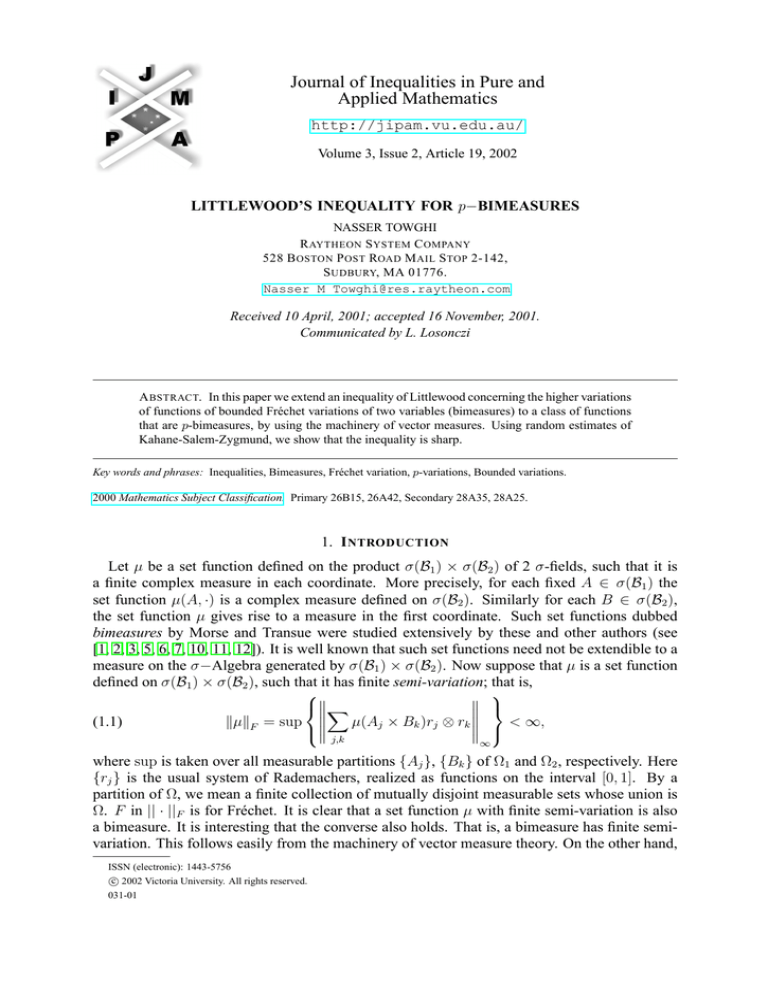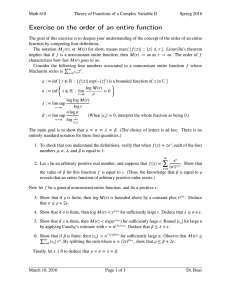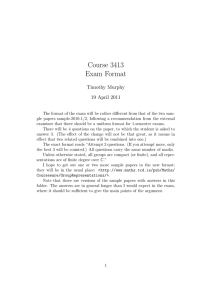
Journal of Inequalities in Pure and
Applied Mathematics
http://jipam.vu.edu.au/
Volume 3, Issue 2, Article 19, 2002
LITTLEWOOD’S INEQUALITY FOR p−BIMEASURES
NASSER TOWGHI
R AYTHEON S YSTEM C OMPANY
528 B OSTON P OST ROAD M AIL S TOP 2-142,
S UDBURY, MA 01776.
Nasser_M_Towghi@res.raytheon.com
Received 10 April, 2001; accepted 16 November, 2001.
Communicated by L. Losonczi
A BSTRACT. In this paper we extend an inequality of Littlewood concerning the higher variations
of functions of bounded Fréchet variations of two variables (bimeasures) to a class of functions
that are p-bimeasures, by using the machinery of vector measures. Using random estimates of
Kahane-Salem-Zygmund, we show that the inequality is sharp.
Key words and phrases: Inequalities, Bimeasures, Fréchet variation, p-variations, Bounded variations.
2000 Mathematics Subject Classification. Primary 26B15, 26A42, Secondary 28A35, 28A25.
1. I NTRODUCTION
Let µ be a set function defined on the product σ(B1 ) × σ(B2 ) of 2 σ-fields, such that it is
a finite complex measure in each coordinate. More precisely, for each fixed A ∈ σ(B1 ) the
set function µ(A, ·) is a complex measure defined on σ(B2 ). Similarly for each B ∈ σ(B2 ),
the set function µ gives rise to a measure in the first coordinate. Such set functions dubbed
bimeasures by Morse and Transue were studied extensively by these and other authors (see
[1, 2, 3, 5, 6, 7, 10, 11, 12]). It is well known that such set functions need not be extendible to a
measure on the σ−Algebra generated by σ(B1 ) × σ(B2 ). Now suppose that µ is a set function
defined on σ(B1 ) × σ(B2 ), such that it has finite semi-variation; that is,
X
(1.1)
kµkF = sup µ(Aj × Bk )rj ⊗ rk < ∞,
j,k
∞
where sup is taken over all measurable partitions {Aj }, {Bk } of Ω1 and Ω2 , respectively. Here
{rj } is the usual system of Rademachers, realized as functions on the interval [0, 1]. By a
partition of Ω, we mean a finite collection of mutually disjoint measurable sets whose union is
Ω. F in || · ||F is for Fréchet. It is clear that a set function µ with finite semi-variation is also
a bimeasure. It is interesting that the converse also holds. That is, a bimeasure has finite semivariation. This follows easily from the machinery of vector measure theory. On the other hand,
ISSN (electronic): 1443-5756
c 2002 Victoria University. All rights reserved.
031-01
2
NASSER T OWGHI
it is well known that a set function which has finite semi-variation need not have finite total
variation (in the sense of Vitali), hence it may not be extendible to a measure [2, 9]. However,
all is not lost, in his 1930 paper, Littlewood showed that a bimeasure has finite 4/3-variation. To
make this precise we first introduce the notion of mixed variation of µ. Let p, q > 0, and define
the mixed (p, q)-variation of µ to be
! pq 1q
X X
(1.2)
kµkp,q = sup
,
|µ(Aj × Bk )|p
k
j
where the sup is taken over all finite measurable partitions {Aj } and {Bk } of Ω1 and Ω2 respectively. In the case that p = q, we simply write kµkp , that is kµkp = kµkp,p . We now state
Littlewood’s 4/3 inequalities.
1.1. Littlewood’s Inequalities.
(1.3)
kµk2,1 + kµk1,2 + kµk4/3 ≤ c kµkF ,
where c is a fixed universal constant. The result is sharp in the sense that, there exists µ ∈ such
that kµkp and kµkq,1/q are infinite for all p < 4/3 and for all q < 2. Extension of Littlewood’s
inequality to a larger class of functions of two variables is the main result of this paper.
Definition 1.1. A set function µ defined on product of two algebras B 1 ×B2 is called a pre-pbimeasure, if it is finitely additive in each coordinate, and for each fixed A ∈B1 , the quantity
(
)
X
p
BVp (µ(A, ·)) := sup
|µ(A × Bk |
k
is finite, and for each fixed B ∈B2 , BVp (µ(·, B)) is finite. Here sup is taken over all finite
measurable partitions of Ω2 .
If the set function is defined on the product of two σ-algebras with above properties, then it
is called a p-bimeasure.
Definition 1.2. A pre-p-bimeasure µ defined on product of two algebras B 1 ×B2 , is said to be
bounded, if there exists a positive constant M such that BVp (µ(A, ·)) + BVp (µ(·, B)) ≤ M , for
all A ∈B1 and for all B ∈B2 .
We prove the following result.
Theorem 1.1. Suppose that either µ is a p-bimeasure defined on σ(B1 ) × σ(B2 ), or that it is a
bounded pre-p-bimeasure defined on B1 ×B2 . If 1 ≤ p ≤ 2 then
(1.4)
kµk2,p + kµkp,2 + kµk
4p
2+p
< ∞.
In the case that p ≥ 2, then
(1.5)
kµkp < ∞.
Furthermore, the result is sharp, in the sense that, there exists a p-bimeasure such that kµkq =
4p
.
∞, for all q < 2+p
To prove Theorem 1.1 we collect some definitions and results about vector measures. Much
of the following can be found in Chapter 1 of [4].
Definition 1.3. A function µ from a field B of a set Ω to a Banach space is called a finitely additive vector measure, or simply a vector measure, if whenever A1 and A2 are disjoint members
J. Inequal. Pure and Appl. Math., 3(2) Art. 19, 2002
http://jipam.vu.edu.au/
L ITTLEWOOD ’ S I NEQUALITY
3
S
of B then µ (A1 A2 ) = µ(A1 ) + µ(A2 ). The variation of a vector measure µ is the extended
nonnegative function |µ| whose value on the set E is given by
X
|µ|(A) = sup
||µ(A)||,
π
A∈π
where the sup is taken over all partitions π of A into a finite number of disjoint members of B.
If |µ|(Ω) is finite, then µ will be called a measure of bounded variation.
A different type of variation related to a vector measure µ is the so called semi-variation of
µ. More precisely, the semi-variation of µ is the extended nonnegative function kµkF whose
value on a measurable set A is given by
kµkF (A) = sup {|x∗ (µ)|(A) : x∗ ∈ X ∗ , kx∗ k ≤ 1} ,
where |x∗ (µ)| is the variation of the real-valued measure (finitely additive measure) x∗ (µ). If
kµkF (Ω) is finite, then µ will be called a measure of bounded semi-variation.
2. P ROOF OF T HEOREM 1.1
We now prove Theorem 1.1. Suppose that 1 ≤ p < 2. Let X1 be the space of finitely
additive set functions defined on σ(B1 ), which have finite p-variations. Similarly let X2 be the
set finitely additive functions defined on σ(B2 ) which have finite p-variations. It can be shown
that equipped with p-variation norm, X1 and X2 are Banach spaces. Let L be the X1 -valued
function defined on σ(B2 ) as follows: L(A) = µ(·, A), where A ∈ σ(B2 ). Let R be the X2 valued function defined on σ(B1 ) as follows: R(A) = µ(A, ·), where A ∈ σ(B1 ). If µ is a
p-bimeasure then by the Nikodym Boundedness Theorem (see [4, Theorem 1, page 14]), L and
R have finite semi-variations. If µ is a bounded pre-p-bimeasure then by general properties of
vector measures (see e.g., [4, Proposition 11, page 4]), L and R have finite semi-variations. Let
{An } be a finite measurable partition of Ω2 and {Bk } be a finite measurable partition of Ω1 ,
then
(2.1)
∞ > ||L||F (Ω2 )
!
X
≥ BVp
rn µ(An , ·) n
∞
p ! 1 p
X X
r
µ(A
,
B
)
≥ n
n
k
k n
∞
! p1
Z 1 X X
p
≥
rn (x)µ(An , Bk ) dx
n
0
k
! p2 p1
X X
(Khinchin’s inequality) ⇒ ≥ c
|µ(An , Bk )|2 .
k
n
Similarly,
! p2 p1
(2.2)
∞ > ||R||F (Ω1 ) ≥ c
X X
n
J. Inequal. Pure and Appl. Math., 3(2) Art. 19, 2002
|µ(An , Bk )|2
.
k
http://jipam.vu.edu.au/
4
NASSER T OWGHI
(2.2) and (2.3) imply that, kµk2,p is finite. Applying Minkowski’s inequality we obtain kµkp,2 ≤
kµk2,p < ∞. We now show that kµk 4p is finite. Let an,k = µ(An , Bk ). Applying Hölder’s
2+p
inequality with exponents
X
(2.3)
2+p
p
4p
|an,k | 2+p =
2+p
,
2
and
X
we obtain
2p
2p
|an,k | 2+p |an,k | 2+p
n,k
n,k
≤
"
X X
n
"
≤
2
# p+2
X
|an,k |2
k
|an,k |p
k
p
2
# 2+p
! p2 2+p
X
X
XX
p
|an,k |p
(
|an,k |2 ) 2
n
≤
p "
# 2+p
n
k
kµk2,p kµkp,2
2p
p+2
k
< ∞.
This proves inequality (1.5). If p ≥ 2 then p/2 ≥ 1, consequently
! p2 p1
||R||F (Ω1 ) ≥ c
(2.4)
X X
n
|µ(An , Bk )|2
k
!! p1
≥ c
X X
k
|µ(An , Bk )|p
.
n
Similarly
!! p1
||L||F (Ω2 ) ≥ c
X X
k
|µ(An , Bk )|p
.
n
This proves inequality (2.1).
4p
We now show that the exponent p+2
is sharp. We only consider the case 1 < p < 2. Sharpness
of Theorem 1.1 for the case p = 1 is known [9]. Sharpness of Theorem 1.1 for p ≥ 2 is trivial.
We need the following result, which is a consequence of Kahane-Salem-Zygmund estimates
(see [8, Theorem 3, p. 70]).
Lemma 2.1. Let Xn1 ,n2 ,...ns be a subnormal collection of independent random variables. Given
complex numbers cn1 ,n2 ,...,ns , where the multi-index (n1 , n2 , ..., ns ) satisfies |n1 | + |n2 | + · · · +
|ns | ≤ N , then
(2.5)
Pr
X
i 21 h X
i(n1 t1 +···ns ts ) 2
sup Xn1 ,n2 ,...ns cn1 ,n2 ,...,ns e
|cn1 ,n2 ,...,ns | log N
≥C s
t1 ,...,ts
≤ N −2 e−s ,
where C is an independent constant.
To apply Lemma 2.1, we will need to construct an appropriate sequence of independent
subnormal random variables. We will construct a Radamacher type of system, which we will
call the 4-level Radamacher system.
J. Inequal. Pure and Appl. Math., 3(2) Art. 19, 2002
http://jipam.vu.edu.au/
L ITTLEWOOD ’ S I NEQUALITY
5
2.1. 4-level Radamacher System. 4-level Radamacher system is the sequence of independent
random variables, {wj (x)}∞
j=1 , defined on the unit interval [0, 1], such that each wj takes on
4 discrete values {2, −2, 1, −1}, each with probability 41 . Such a system can be constructed
similar to the usual Radamacher system. Observe that, M 4-level Radamacher system generate
4M distinct vectors of length M . On the other hand the set {1, 2, ..., M } has 2M distinct subsets.
~t = (t1 , t2 ) and choice of scalers
By Lemma 2.1, for j, k = 1, ..., M , there exists
Ma2 vector
1
M
M2
{bjk }j,k=1 (approximately as many as 1 − M 2 4 − 2 ), such that bjk ∈ {2, −2, 1, −1},
and for any subset A of {1, 2, ..., M },
X
1
(2.6)
bjk ei(kt1 +jt2 ) ≤ C[4M log(2M )] 2 ,
j∈A
and
X
1
i(kt1 +jt2 ) bjk e
≤ C[4M log(2M )] 2 .
(2.7)
k∈A
Let
M
(a) = {ajk }j,k = bjk ei(jt1 +kt2 ) j,k=1 .
(2.8)
Let A, B ⊂ {1, 2, ..., M } and define
a(A, B) =
(2.9)
XX
ajk ,
j∈A k∈B
then by virtue of inequalities (2.7) and (2.8),
1
1
||a||F ≤ Cp M 2 + p
(2.10)
p
log(2M ).
On the other hand for any r > 0,
"
||a||r =
(2.11)
M X
M
X
# r1
2
|ajk |r
≥ Mr.
j=1 k=1
We see that if r <
4p
,
p+2
||a||r
= ∞.
M →∞ ||a||F
lim
(2.12)
4p
This shows that p+2
is sharp. The proof for the case that µ is a bounded-pre-bimeasure is similar.
3. F UNCTIONS OF B OUNDED p-VARIATIONS AND R ELATED F UNCTION S PACES
Let p ≥ 1 and f be a function defined on [0, 1]2 . Let
!1/p
Vp(2) (f, [0, 1]2 ) =
sup
π1 ,π2
X
|∆πi,j1 ,π2 f |p
.
i,j
Here π1 = {0 = x0 < x1 , < · · · < xm = 1}, and π2 = {0 = y0 < y1 , < · · · < yn = 1}, are
partitions of [0, 1] and
∆πi,j1 ,π2 (f ) = f (xi , yj ) − f (xi , yj−1 ) − f (xi−1 , yj ) + f (xi−1 , yj−1 ).
(2)
(2)
Let Wp ([0, 1]2 ) = Wp denote the class of functions f on [0, 1]2 such that,
||f ||Wp2 = Vp(2) (f, [0, 1]2 ) + Vp(2) (f (0, ·), [0, 1]) + Vp(1) (f (·, 0), [0, 1]) + |f (0, 0, 0)| < ∞.
J. Inequal. Pure and Appl. Math., 3(2) Art. 19, 2002
http://jipam.vu.edu.au/
6
NASSER T OWGHI
Let ~x = (x1 , x2 ), ~y = (y1 , y2 ) ∈ [0, 1]2 , and f be a function defined on [0, 1]2 . Let
f~y (~x) = f (x1 , x2 ) − f (x1 , y2 ) − f (y1 , x2 ) + f (y1 , y2 ).
We say that f is a Lipschitz function of order α of first type, if there exists a constant C such
that for all ~x and ~y in [0, 1]2 ,
|f (~x) − f (~y )| ≤ C||~x − ~y ||α2 .
(3.1)
Here || · ||2 refers to the usual l2 -norm. The class of Lipschitz functions of order α of first type
is denoted by Λ1α (2). We say that f is a Lipschitz function of order α of second type, if there
exists a constant C such that for all ~x and ~y in [0, 1]2 ,
|f~y (~x)| ≤ C||~x − ~y ||α2 .
(3.2)
The class of Lipschitz functions of order α of second type is denoted by Λ2α (2). If f ∈ Λ1α (2)
then
|f~y (~x)| ≤ 4C min{|xj − yj |α : 1 ≤ j ≤ 2} ≤ C2 ||~x − ~y ||α2 }.
Therefore, Λ1α (2) ⊂ Λ2α (2). Using Theorem 1.1 we obtain
Corollary 3.1. Let f be a function defined on [0, 1]2 . Suppose that for any 1 ≤ j ≤ n and for
any fixed partitions π1 and π2 of the interval [0, 1], we have
"
#1/p
"
#1/p
X π ,π
X π,π
(3.3)
sup
|∆i,j1 f |p
+ sup
|∆i,j 2 f |p
≤ M < ∞,
π
then f ∈ W
(2)
4p
2+p
i,j
π
i,j
.
R EFERENCES
[1] R.C. BLEI, Fractional dimensions and bounded fractional forms, Mem. Amer. Math. Soc., 57
(1985), No. 331.
[2] R.C. BLEI, Multilinear measure theory and the Grothendieck factorization theorem, Proc. London
Math. Soc., 56(3) (1988), 529–546.
[3] R.C. BLEI, An Extension theorem concerning Fréchet measures, Can. Math. Bull., 38 (1995), 278–
285.
[4] J. DIESTEL AND J.J. UHL, Jr., Vector Measures, Math Surveys 15, Amer. Math. Soc., Providence,
(1977).
[5] M. FRÉCHET, Sur les fonctionnelles bilinéaires, Trans. Amer. Math. Soc., 16 (1915), 215–234.
[6] A. GROTHENDIECK, Résumé de la théorie métirque des produits tensoriels topologiques, Bol.
Soc. Matem. São Paulo, 8 (1956), 1–79.
[7] C.C. GRAHAM AND B.M. SCHREIBER, Bimeasure algebras on LCA groups, Pacific Journal of
Math., 115 (1984), 91–127.
[8] J.P. KAHANE, Some Random Series of Functions, 2nd edition, Cambridge University Press, Heath
(1986).
[9] J.E. LITTLEWOOD, On bounded bilinear forms in an infinite number of variables, Quart. J. Math.
Oxford, 1 (1930), 164–174.
[10] M. MORSE AND W. TRANSUE, Functionals of bounded Fréchet variation, Canad. J. Math., 1
(1949), 153–165.
[11] M. MORSE AND W. TRANSUE, Integral representations of bilinear functionals, Proc. Nat. Acad.
Sci., 35 (1949), 136–143.
J. Inequal. Pure and Appl. Math., 3(2) Art. 19, 2002
http://jipam.vu.edu.au/
L ITTLEWOOD ’ S I NEQUALITY
7
[12] M. MORSE AND W. TRANSUE, C-bimeasures Λ and their integral extensions, Ann. Math., 64
(1956), 89–95.
J. Inequal. Pure and Appl. Math., 3(2) Art. 19, 2002
http://jipam.vu.edu.au/








